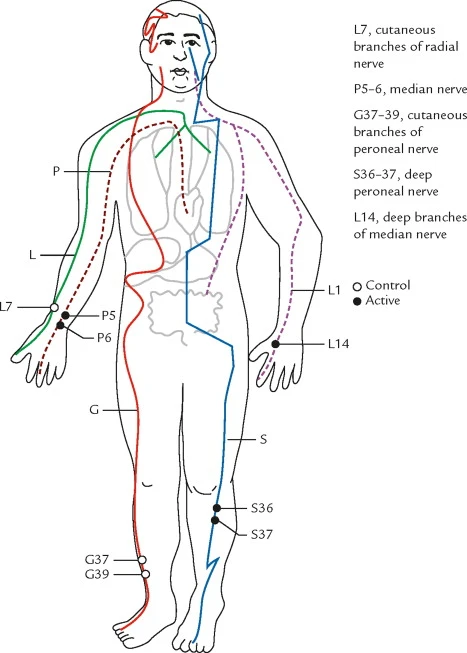This post may contain affiliate links and ads in which we may earn a small percentage of purchases.
Overview
Meridians are a fascinating concept in acupuncture theory and Traditional Chinese Medicine (TCM) overall. There is no MRI showing that “meridians” exist per se, but in TCM, the way to understand it is to look at what bodily functions the meridians and acupuncture points represent.

If you’ve ever quit because meal plans felt overwhelming, this approach keeps it simple. The 21-Day Smoothie Diet gives you daily guidance, a detox reset, and easy recipes—so you can focus on consistency instead of planning. Instant digital access. Start today.
In other words, a meridian may have been discovered based on a grouping of system functions or how the points along the meridians affected the body. This is why if someone just uses a blanket statement such as “qi doesn’t exist or meridians don’t exist,” it may just be a lack of understanding that acupuncture theory focuses on groups of processes and functions in the body.
So What Are Acupuncture Meridians?
Meridians in acupuncture theory are the channels that carry the energy from acupuncture points. They can be likened to the nervous system, even though they are not nerves, but they operate in a similar way. When you get deeper into TCM theory, the acupuncture meridians help connect the outer part of the body to the inside, meaning helping the points connect to the internal organs[1].
Scientific Basis of Acupuncture Meridians
An understanding of the scientific basis underlying acupuncture meridians is essential for bridging traditional knowledge with modern scientific standards. By examining traditional theory and practice with contemporary science, we can a gain deeper understanding into the mechanisms of the therapy.
A clear and beginner-friendly guide covering over 400 acupuncture points, ideal for students and learners.
 View Book
View Book
A stainless-steel acupuncture pen and gua sha set for massage, reflexology, and tension relief.
 View Product
View Product
Current Research and Theories on Acupuncture Meridians
In recent years (about the last 25 years from the date of this article), advances in research methodologies and technologies have shed new light on the physiological, anatomical, and neurobiological mechanisms of acupuncture, and within the realm of understanding the inner workings, the meridians as well.
The Nervous System (Central and Peripheral)
A 2010 study pointed out that “the most recent and consistent observation has been the location of acupoints and meridians over larger mixed nerve bundles containing motor units, as well as sensory fibers, that project to regions in the central nervous system that regulate pain and blood pressure, i.e., conditions that appear to be influenced by acupuncture” [2].
Bio-science also looks at the peripheral and central nervous systems to be the most rational basis for defining meridians [3]. That may change in time with time and research, but
Muscle Fascia
The human body’s fascia network may be the physical material represented by the meridians of TCM. In 80% of acupuncture points, a bundle of vascular nerves of soft connective tissue passes through fascia holes to the skin [4].
Furthermore, in the 2019 study the authors found “fascia superficialis corporis of the human extracellular matrix” provides the structural basis for acupuncture meridians[5].
Other scientific based characteristics may include electric characteristics (i.e., high-electrical potential, conductance, and capacitance, low impedance and resistance), thermal characteristics (i.e., infrared radiant tracking along the meridians), and magnetic characteristics (i.e., a relatively stable circular current of electromagnetic and chemical oscillation along the low electric resistance pathway)[6].

A 2002 study further explores the hypothesis that acupuncture points and meridians are associated with connective tissue planes. It suggests the possibility that the mechanical coupling between the needle and connective tissue during acupuncture needling could influence cell signaling and tissue remodeling. This mechanical coupling, known as “needle grasp,” is thought to enhance the therapeutic effects by delivering mechanical signals into the connective tissue, which can be transduced into bio-electrical and biochemical signals [7].
Electric Characteristics
These properties can be linked to the body’s known bio-electrical activities. Research has shown that acupuncture points often exhibit different electrical properties compared to surrounding tissues. Further exploration into how these electrical properties influence physiological functions and therapeutic outcomes could provide more valuable insight.
Thermal Characteristics
Thermal characteristics, such as infrared radiant tracking along the meridians can also be a way to understand the pathway of acupuncture meridians. Infrared imaging has been used in various studies to detect thermal changes in the body. These changes could be correlated with blood flow and metabolic activity, which are influenced by acupuncture. Researching thermal patterns could help to understand how acupuncture affects local and systemic circulation and metabolism.
Magnetic Characteristics
The human body generates and responds to magnetic fields, and the interaction of these fields with acupuncture points and meridians could be an excellent area of exploration. Research could focus on how these magnetic properties influence cellular processes and overall health.
The Importance of Research and Understanding
So why are meridians important? Do we see pathological conditions that coincide with the direction or path of the different meridians in the body clinically? Yes. As more research is conducted and understood, we can better understand why this is so.
How To Better Understand Meridians and Traditional Chinese Medicine
For instance, Stomach 36 is good for energy and digestion, but does it provide the “energy”? No, it regulates the digestive system for proper functioning and gives you a host of other benefits through a process. This is how we are able to understand ancient texts and translate them into current anatomical and physiological knowledge. This leads to being able to create a working hypothesis and then go from there.
Just like science, different models are integrated as time goes on. The Bohr model was the best explanation for hydrogen and atoms and different shells and levels at the time, but it didn’t explain everything, and newer models were built. However, the Bohr model still remained relevant and helped lead to further discoveries. The same thing applies to meridians. We have 12 main meridians and 8 extra meridians (known as collateral meridians). Systems are made to evolve, grow, and explain the unexplainable, and even have rules.
To Summarize
- Acupuncture meridians play a fundamental role in Traditional Chinese Medicine (TCM) and the practice of acupuncture in general.
- Recent scientific research provides compelling evidence for better understanding of the characteristics of acupuncture meridians, utilizing anatomical, physiological, and neurobiological correlates.
- Anatomical studies have linked meridians to the human fascia network and connective tissue planes, establishing a structural foundation for their existence.
- Neuroimaging studies demonstrate the involvement of the central and peripheral nervous systems in acupuncture’s mechanisms of action, supporting the role of meridians as pathways for energy and information flow.
- Despite challenges in research methodologies, ongoing interdisciplinary research continues to advance our understanding of acupuncture meridians and their clinical significance, highlighting their potential for integrative healthcare.
In future articles, we will go over the meridians in more detail. For now, hopefully, this gives you a basic understanding to work with.
References
1,4,5. Litscher, G., Maurer, N., Nissel, H., Egerbacher, M., Gornik, E., Schuller, P., & Traxler, H. (2019). Anatomical Evidence of Acupuncture Meridians in the Human Extracellular Matrix: Results from a Macroscopic and Microscopic Interdisciplinary Multicentre Study on Human Corpses. Evidence-Based Complementary and Alternative Medicine, 2019, 6976892. https://doi.org/10.1155/2019/6976892
2,3. Longhurst, J. C. (2010). Defining Meridians: A Modern Basis of Understanding. Journal of Acupuncture and Meridian Studies, 3(2), 67-74. Retrieved June 1st, 2024 https://www.sciencedirect.com/science/article/pii/S2005290110600143?via%3Dihub
6. Ahn, A. C., Colbert, A. P., Anderson, B. J., Martinsen, Ø. G., Hammerschlag, R., Cina, S., Wayne, P. M., & Langevin, H. M. (2012). Biophysical Characteristics of Meridians and Acupoints: A Systematic Review. Evidence-Based Complementary and Alternative Medicine, 2012, 793841. Retrieved June 1st, 2024 from https://www.ncbi.nlm.nih.gov/pmc/articles/PMC3546562/
7. Langevin, H. M., & Yandow, J. A. (2002). Relationship of acupuncture points and meridians to connective tissue planes. The Anatomical Record, 269(6), 257-265. Retrieved June 1st, 2024 https://onlinelibrary.wiley.com/doi/full/10.1002/ar.10185
Medical Disclaimer: This article is for informational and educational purposes only and is not a substitute for professional medical advice, diagnosis, or treatment. Always consult a qualified healthcare provider with any questions about a medical condition or treatment.





